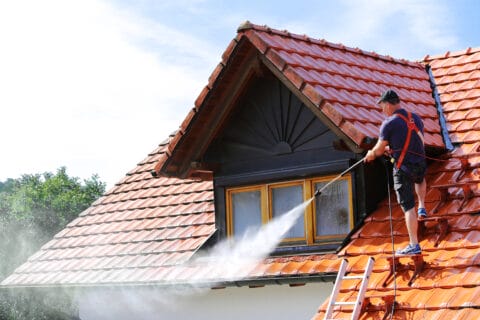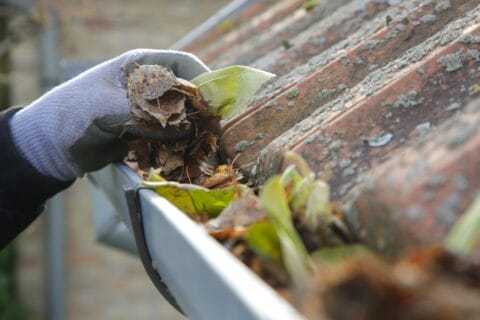How To Prevent Ice Dams In Gutters
 Revised by Bruce Hulse
Revised by Bruce Hulse
Understanding Ice Dams: Causes and Effects
Ice dams are a common winter problem for homeowners in Ottawa and other cold regions. They form when the upper parts of a roof are warmer than the lower edges. Snow melts on the warmer surfaces and then refreezes once it reaches the colder eaves and gutters. Over time, this creates a solid ridge of ice that blocks normal drainage.
When water cannot flow freely, it seeps under shingles and into the roof deck, insulation, and even the walls of a home. Ottawa’s frequent freeze-thaw cycles mean ice dams can form quickly and return several times in one season. Beyond water leaks, they add heavy weight to gutters, which can cause them to sag or pull away from the house.
The key to prevention is understanding that ice dams are not just cosmetic. They threaten both the roof structure and the gutter system, which makes them an issue every homeowner should take seriously.
Key Risks Associated With Ice Dams
Ice dams cause both visible and hidden damage, and the longer they remain, the more costly repairs become.
Main Risks
- Roof and shingle damage: Trapped ice can crack or lift shingles, exposing the roof deck to water.
- Interior leaks: Meltwater inside the home leads to ceiling stains, soaked insulation, and mold growth.
- Gutter strain: The weight of ice may distort gutter slope or cause sections to detach.
- Health concerns: Persistent dampness promotes mold and mildew, which can affect indoor air quality.
| Risk | Potential Consequence | Long-Term Impact |
| Roof damage | Cracked or lifted shingles | Costly roof replacement |
| Interior leaks | Stained ceilings, wet insulation | Mold growth, reduced energy efficiency |
| Gutter strain | Detached or bent gutters | Ineffective drainage, foundation issues |
| Mold and mildew | Respiratory irritation | Ongoing health and structural risks |
Prompt prevention is far less expensive than emergency repairs. In a climate like Ottawa’s, where winters are long and harsh, addressing risks early is the most practical approach.
Preventive Measures: Insulation, Air Sealing, and Ventilation
The most reliable way to prevent ice dams is to maintain an even roof temperature from top to bottom. This is done by reducing heat loss from inside the home.
Proper Roof Insulation
Insulation is the first defense against ice dams. It keeps heated air inside living spaces rather than letting it rise into the attic and warm the roof deck unevenly. Homeowners should choose insulation with a high R-value, which is a measure of how well insulation resists heat flow. The higher the R-value, the better it performs. Just as important is making sure insulation is spread evenly, so there are no hot spots that cause snow to melt in patches.
Air Sealing
Insulation only works well if warm air is not leaking into the attic. Common escape points include attic hatches, chimneys, and plumbing vents. Sealing these gaps (known as air sealing) prevents warm air from reaching the roof deck. Many older Ottawa homes have small gaps that add up to significant heat loss, which makes air sealing especially important.
Balanced Ventilation
Good ventilation balances attic temperatures by bringing in cold outdoor air and expelling any warm air that rises. Soffit vents (located under roof overhangs) and ridge vents (at the top of the roof) are often paired to create steady airflow. Mechanical ventilation can be used as a backup but should not replace insulation and air sealing.
Gutter Maintenance Tips to Avoid Ice Dams
Even with good insulation and ventilation, clogged or damaged gutters can make ice dams worse. Gutters are essential for directing water away from the house, so keeping them clear is a major part of prevention.
Best Practices for Gutter Care
- Clean gutters in late fall to remove leaves and debris.
- Ensure gutters slope slightly downward so water drains properly.
- Inspect gutters and downspouts before winter for cracks or blockages.
- Install gutter guards to reduce buildup of twigs and leaves.
| Gutter Task | Benefit | Recommended Frequency |
| Cleaning debris | Prevents overflow and blockages | Twice a year |
| Checking slope | Ensures proper water flow | Before winter |
| Inspecting for damage | Identifies weak spots early | Seasonal |
| Adding gutter guards | Reduces buildup of debris | One-time installation |
Some homeowners add heat cables to gutters and roof edges. These cables warm problem areas to melt channels through ice. They can be useful, but they should never replace regular cleaning and inspection. For Ottawa homeowners, professional gutter cleaning before the snow season is one of the most effective ways to prepare.
Removing Existing Ice Dams Safely
If ice dams do appear, acting quickly can prevent serious damage.
- Roof rakes: Long-handled rakes allow snow to be removed from roof edges while standing safely on the ground.
- Calcium chloride: Special ice melt products designed for roofs break down ice without damaging shingles. Avoid using rock salt, which can corrode roofing materials.
- Pantyhose method: A simple trick involves filling pantyhose with calcium chloride and placing them across the ice. This melts a narrow path that allows trapped water to escape.
These methods are temporary fixes. Climbing onto a roof in icy conditions is dangerous, so professional ice dam removal is usually the safest option.
Professional Solutions and When To Call for Help
Sometimes prevention and DIY fixes are not enough. When ice dams keep returning or cause visible damage, professional help is the best solution.
- Weatherization contractors can perform a blower door test, which uses a special fan to find air leaks in the home. They often combine this with thermal imaging cameras to pinpoint heat loss.
- Insulation and roofing experts upgrade homes to meet building codes and reduce long-term risks.
- Professional gutter services remove ice safely and reinforce gutters so they are less likely to fail under heavy snow and ice.
For Ottawa homeowners, turning to a local service like Clear Ottawa Windows ensures solutions are based on local weather conditions and construction styles.
DIY Strategies and Safety Precautions
Many prevention steps can be handled by homeowners, such as adding insulation, sealing visible leaks, or installing gutter guards. However, safety must come first.
When working on a roof or ladder in winter, always use a safety harness, avoid working alone, and never attempt repairs during storms or freezing rain. If conditions feel unsafe, it is far better to call in professionals who have the equipment and training to handle ice and snow safely.
Frequently Asked Questions
Can insulation alone prevent ice dams?
No. Insulation is important, but it works best when combined with ventilation and air sealing.
Do heat cables work on their own?
Not entirely. Heat cables are helpful in specific spots but should not replace proper insulation and gutter care.
What are early warning signs?
Icicles along gutters, water stains on ceilings, and damp attic insulation are clear signs that ice dams may be forming.
Conclusion
Ice dams can cause major damage if left untreated, but with the right approach, they are entirely preventable. By combining insulation, air sealing, ventilation, and gutter maintenance, homeowners can keep their homes safe throughout Ottawa’s long winters.
DIY steps are helpful, but professional inspections and maintenance provide the most reliable protection. Clear Ottawa offers trusted gutter cleaning and roof care services designed to protect homes against the unique challenges of our climate.
Key Summary
| Focus Area | Key Actions | Benefit |
| Insulation | Install high R-value insulation evenly | Reduces heat loss |
| Air Sealing | Seal gaps around chimneys, vents, attic access | Prevents hot spots |
| Ventilation | Add ridge and soffit vents for airflow | Maintains uniform roof temps |
| Gutter Care | Clean, slope-check, install guards | Ensures proper drainage |
| Ice Removal | Use roof rake, calcium chloride, pantyhose | Provides short-term relief |
| Professional Help | Gutter cleaning, insulation upgrades, weatherization | Long-term prevention |


